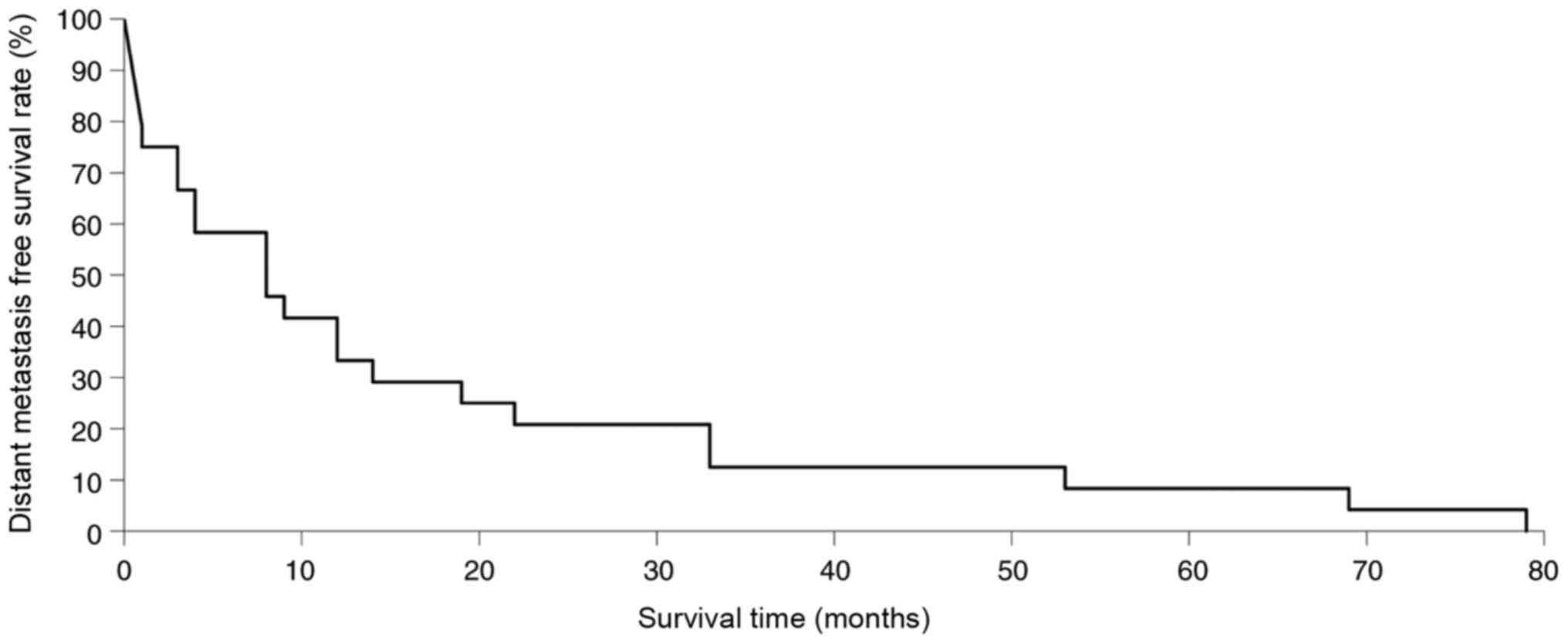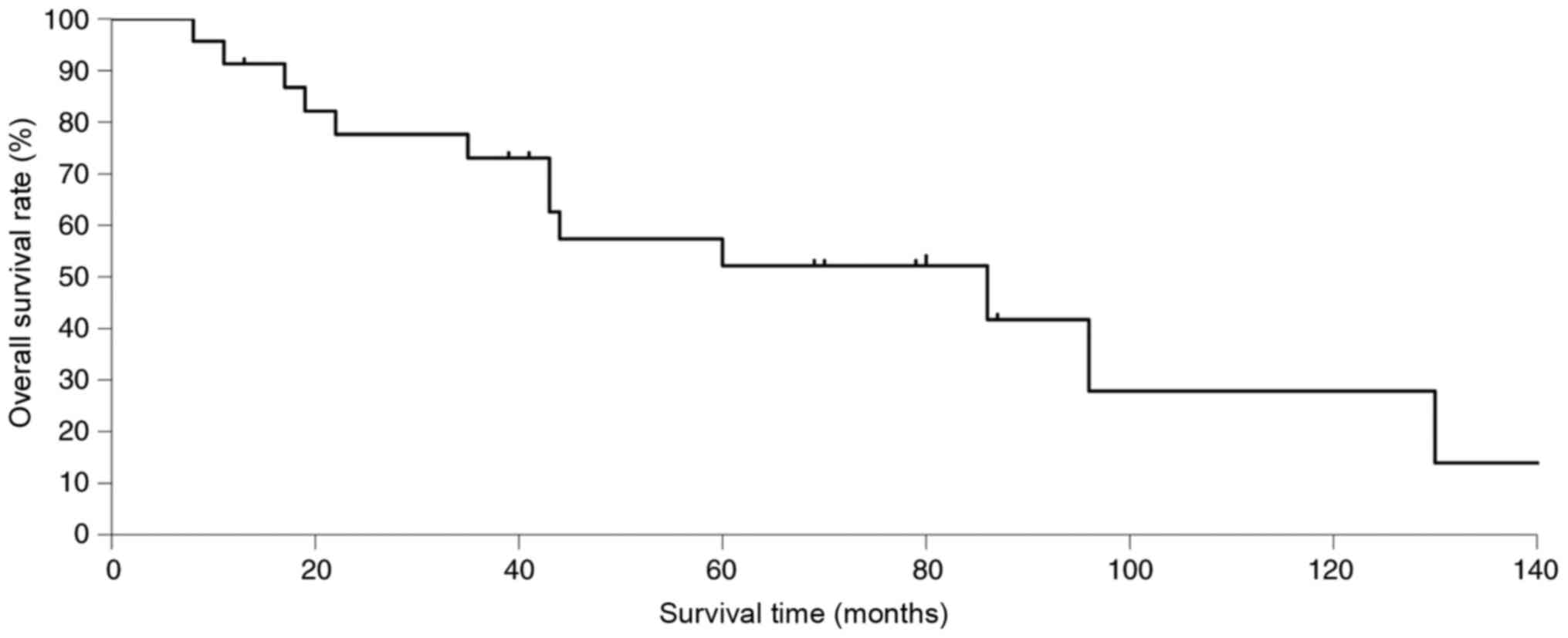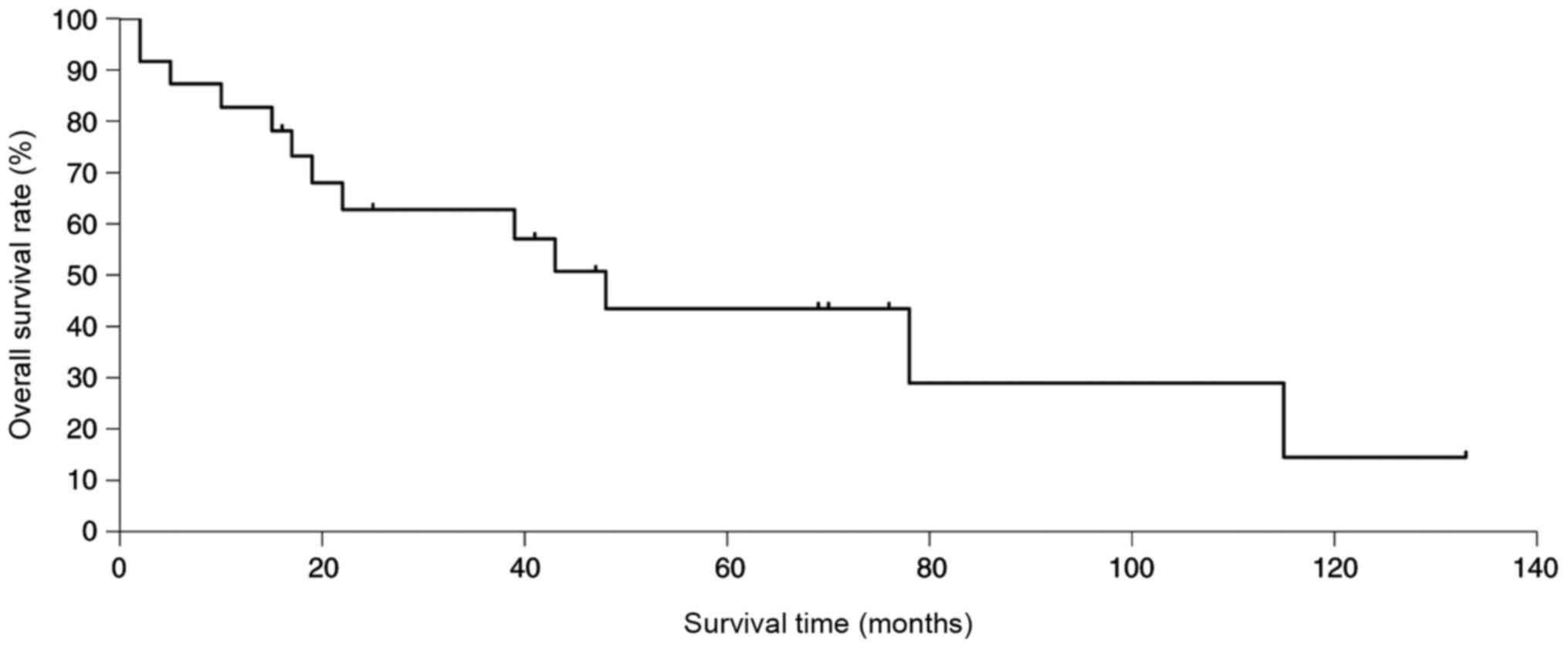Introduction
Carcinomas arising from salivary glands, such as the
parotid, submandibular, sublingual, and minor salivary glands, are
relatively uncommon (1-4).
A large number of clinical statistics have been reported for
salivary gland carcinoma (5-9).
The treatment of salivary gland cancer generally involves surgery
and postoperative radiotherapy (5,6,10).
However, these are often insufficient for high-grade disease, and
recurrence or metastasis often occurs, leading to a poor prognosis
(4,11). The prognosis depends on the site of
origin, histopathology, and staging (1,12) of
the carcinoma. However, the small number of cases and variety of
pathological presentations make it difficult to study a coherent
number of cases on a consistent basis. Furthermore, the treatment
of patients with distant metastases, which are more difficult to
treat, varies between centres. There have been few studies on
distant metastases in salivary adenocarcinoma, and few reports on
their treatment and prognosis. In the present study, we
investigated the prognosis of patients with distant metastases from
salivary gland carcinoma.
Materials and methods
Patient selection
The subjects included 24 patients with salivary
gland carcinoma with distant metastasis, initially treated at the
Department of Otolaryngology-Head and Neck Surgery, Nara Medical
University, during a 16-year period from August 2004 to July 2020.
The observation period ranged from 2 to 133 months (median 23.5
months).
Prognostic factors
We examined the time to distant metastasis, overall
survival, overall survival based on the date of detection of
distant metastasis, and differences in survival based on the date
of distant metastasis detection according to sex, age, site of
origin, number of metastatic organs, stage, and whether the
metastasis was resectable.
Statistical analysis
Statistical analyses were performed using StatMate V
statistical software (ATMS Co., Ltd.). Overall survival after
salivary gland carcinoma diagnosis with distant metastasis was
analysed using the Kaplan-Meier method, and the groups were
compared using the log-rank test. Statistical significance was set
at P<0.05. A multivariable analysis was not performed because of
the small number of patients.
Results
Clinical characteristics The patients'
ages ranged from 45 to 84 years, with a median age of 68 years
The sample predominantly consisted of male patients,
with 16 males and eight females. The parotid gland was involved in
16 cases, the submandibular gland in 7 cases, and the sublingual
gland in 1 case. In terms of staging, the majority of the cases (18
out of 24) were stage IV (Table I).
As shown in Table II, salivary
duct carcinoma was the most common histological type, with 8 cases,
adenoid cystic carcinoma in 6 cases, and other histological types
with less than 3 cases such as myoepithelial carcinoma (3 cases),
Squamous cell carcinoma (2 cases), Adenocarcinoma (2 cases), Acinic
cell carcinoma (2 cases) and Mucoepidermoid carcinoma (1 case).
Table III shows the TN
classification. Stage IV accounted for three quarters of the total.
As shown in Table IV, the lung was
the most common site of distant metastasis in 20 cases, followed by
the bone, mediastinum, and adrenal gland. As shown in Table V, treatment of distant metastases
included pneumonectomy (6 cases), radiotherapy (6 cases),
chemotherapy (17 cases) which included docetaxel + cisplatin,
docetaxel, TS-1, trastuzumab + paclitaxel, and nivolumab. Of the 17
patients who received chemotherapy after the appearance of distant
metastases, 5 survived: 2 with trastuzumab + paclitaxel and 1 each
with docetaxel+cisplatin, TS-1 and nivolumab.
 | Table ICharacteristics of the patients with
salivary gland carcinoma. |
Table I
Characteristics of the patients with
salivary gland carcinoma.
| Characteristics | No. of patients
(n=24) |
|---|
| Sex | |
|
Female | 8 |
|
Male | 16 |
| Median age, years
(range) | 68 (45-84) |
| Site of cancer
origin | |
|
Parotid
gland | 16 |
|
Submandibular
gland | 7 |
|
Sublingual
gland | 1 |
| Stage | |
|
I-III | 6 |
|
IV | 18 |
 | Table IIHistopathological type of salivary
gland carcinoma. |
Table II
Histopathological type of salivary
gland carcinoma.
| Histopathological
type | No. of patients
(%) |
|---|
| Salivary duct
carcinoma | 8 (33.3) |
| Adenoid cystic
carcinoma | 6 (25.0) |
| Myoepithelial
carcinoma | 3 (12.5) |
| Squamous cell
carcinoma | 2 (8.3) |
| Adenocarcinoma | 2 (8.3) |
| Acinic cell
carcinoma | 2 (8.3) |
| Mucoepidermoid
carcinoma | 1 (4.2) |
 | Table IIIT and N classification of salivary
gland carcinoma with distant metastasis. |
Table III
T and N classification of salivary
gland carcinoma with distant metastasis.
| | T grade |
|---|
| N grade | T1 | T2 | T3 | T4a |
|---|
| N0 | 0 | 4 | 1 | 4 |
| N1 | 0 | 1 | 0 | 0 |
| N2b | 1 | 2 | 3 | 6 |
| N3b | 0 | 0 | 1 | 1 |
 | Table IVSite of distant metastasis. |
Table IV
Site of distant metastasis.
| Site of distant
metastasis | No. of patients
(%) |
|---|
| Lung | 20 (83.3) |
| Bone | 5 (20.8) |
| Mediastinum | 4 (16.7) |
| Adrenal glands | 3 (12.5) |
| Axilla | 2 (8.3) |
| Brain | 2 (8.3) |
| Liver | 1 (4.2) |
| Skin | 1 (4.2) |
 | Table VTreatment of distant metastases. |
Table V
Treatment of distant metastases.
| Treatment type | Number of
patients |
|---|
| No treatment | 3 |
| Surgery | 6 |
| Chemotherapy | 17 |
|
Docetaxel +
cisplatin | 4 |
|
Docetaxel | 5 |
|
TS-1 | 9 |
|
Trastuzumab
+ paclitaxel | 2 |
|
Nivolumab | 2 |
| Radiotherapy | 6 |
Prognostic factors
Approximately 80% of all patients developed distant
metastases within 2 years of the initial diagnosis (Fig. 1). As shown in Fig. 2, the 5-year and 10-year survival
rates after initial treatment were 52.2 and 27.8%, respectively.
After the appearance of distant metastases, the 5-year survival
rates were 43.5% and the 10-year survival rate was 14.5%,
respectively (Fig. 3). As shown in
Table VI, no significant
prognostic factors were found to significantly influence the
long-term prognosis after the appearance of distant metastases
among patients in this study.
 | Table VIPrognostic factors of salivary gland
carcinoma with distant metastasis. |
Table VI
Prognostic factors of salivary gland
carcinoma with distant metastasis.
| Factors | P-value |
|---|
| Sex (female or
male) | 0.172 |
| Age (≥70 vs. <70
years) | 0.718 |
| Tumor location
(parotid gland or Submandibular gland) | 0.229 |
| Number of organs with
distant metastases (≥2 vs. 1) | 0.317 |
| Stage (I-III or
IV) | 0.369 |
| Radical resection
against distant metastasis (+ or -) | 0.057 |
Discussion
The prognosis of salivary gland carcinoma with
distant metastases is poor, and the variety of histopathological
types often makes it difficult to find a well-established
treatment. In the present study, unlike previous reports, salivary
duct carcinoma, rather than adenocarcinoma or adenoid cystic
carcinoma, was the most common type (1,13,14).
This may be because of our focus on cases with distant metastases.
Similar to previous reports, we observed that the carcinoma
occurred predominantly in males, and the parotid gland was the most
common site of occurrence (15,16).
In this study, the 5-year and 10-year survival rates
after the appearance of distant metastases were 43.5 and 14.5%,
respectively. The 5-year survival rate is not low for head and neck
cancer after the appearance of distant metastases, but the 10-year
survival rate is low at 14.5%, which may a feature of salivary
gland carcinoma. Even if the patients survive for more than 5
years, the mortality rate at 10 years would be 70%, suggesting that
long-term observation is necessary.
As shown in Table
VI, sex was not predominantly associated with prognosis. No
details available on hormone regulations of the salivary gland
carcinogenesis. This is a subject for further study. There were no
significant differences in survival according to sex, age, site of
origin, number of metastatic organs, stage, or whether metastases
were resectable. This means that once distant metastases develop,
the prognosis is similar regardless of the number of metastatic
organs or the stage of the disease. However, in other words, even
if the disease has spread to multiple organs and the original stage
is IV, there is still the possibility of long-term prognosis
depending on treatment. In the present study, we were not able to
conduct a comprehensive study because at present there is no
unified treatment plan based on the histopathological type of the
carcinoma, but we hope to study a larger number of cases and
establish better treatment protocols in the future. The only
difference was that patients with resectable metastases tended to
have a longer survival than those with unresectable metastases
(P=0.060). In other words, in patients with distant metastases that
are resectable, resection should be performed whenever possible.
Molecular-targeted therapy and immunotherapy are promising
strategies for refractory carcinoma such as salivary gland
carcinoma. Two patients treated with trastuzumab and one with
nivolumab are alive, but the number of patients is still small and
has not been fully investigated.
In this study, we investigated salivary gland
carcinoma with distant metastasis. There are few reports focusing
on distant metastases, and we believe that this is a valuable
report in this regard. Although the treatment could not be studied
in depth due to aforementioned reasons, we were able to evaluate
the long-term prognosis and prognostic factors among the included
patients in detail. In the future, studies with a larger number of
cases should be performed, and the treatment protocols should be
standardised.
Acknowledgements
Not applicable.
Funding
No funding was received.
Availability of data and materials
The datasets used and/or analyzed during the present
study are available from the corresponding author on reasonable
request.
Authors' contributions
TM, HU, IO and TKit conceived and designed the
current study. TM, HU, IO, TKim, DN, TY, KY and TKit acquired the
data. TM and IO confirmed the authenticity of all the raw data. TM,
HU, IO, TKim and DN analyzed and interpreted the data. TM and TKit
drafted the manuscript. TM, HU, IO and TKit reviewed and edited the
manuscript. All authors have accepted their responsibility for the
entire content of this manuscript and approved submission. All
authors read and approved the final manuscript.
Ethics approval and consent to
participate
The present study was approved by ethics committee
of Nara Medical University Hospital (approval no. 2923). Written
informed consent was obtained from the patients.
Patients consent for publication
Not applicable.
Competing interests
The authors declare that they have no competing
interests.
References
|
1
|
Licitra L, Grandi C, Prott FJ, Schornagel
JH, Bruzzi P and Molinari R: Major and minor salivary glands
tumours. Crit Rev Oncol Hematol. 45:215–225. 2003.PubMed/NCBI View Article : Google Scholar
|
|
2
|
Pinkston JA and Cole P: Incidence rates of
salivary gland tumors: Results from a population-based study.
Otolaryngol Head Neck Surg. 120:834–840. 1999.PubMed/NCBI View Article : Google Scholar
|
|
3
|
Jones AV, Craig GT, Speight PM and
Franklin CD: The range and demographics of salivary gland tumours
diagnosed in a UK population. Oral Oncol. 44:407–417.
2008.PubMed/NCBI View Article : Google Scholar
|
|
4
|
Bell RB, Dierks EJ, Homer L and Potter BE:
Management and outcome of patients with malignant salivary gland
tumors. J Oral Maxillofac Surg. 63:917–928. 2005.PubMed/NCBI View Article : Google Scholar
|
|
5
|
Garden AS, el-Naggar AK, Morrison WH,
Callender DL, Ang KK and Peters LJ: Postoperative radiotherapy for
malignant tumors of the parotid gland. Int J Radiat Oncol Biol
Phys. 37:79–85. 1997.PubMed/NCBI View Article : Google Scholar
|
|
6
|
Gurney TA, Eisele DW, Weinberg V, Shin E
and Lee N: Adenoid cystic carcinoma of the major salivary glands
treated with surgery and radiation. Laryngoscope. 115:1278–1282.
2005.PubMed/NCBI View Article : Google Scholar
|
|
7
|
Forrest J, Campbell P, Kreiger N and Sloan
M: Salivary gland cancer: An exploratory analysis of dietary
factors. Nutr Cancer. 60:469–473. 2008.PubMed/NCBI View Article : Google Scholar
|
|
8
|
Ostman J, Anneroth G, Gustafsson H and
Tavelin B: Malignant salivary gland tumours in Sweden 1960-1989-an
epidemiological study. Oral Oncol. 33:169–176. 1997.PubMed/NCBI View Article : Google Scholar
|
|
9
|
Silas OA, Echejoh GO, Manasseh AN and
Mandong BM: Patterns of malignant salivary gland tumours in Jos
university teaching hospital (JUTH), Jos: A ten-year retrospective
study. Niger J Med. 18:282–285. 2009.PubMed/NCBI View Article : Google Scholar
|
|
10
|
Kaur J, Goyal S, Muzumder S, Bhasker S,
Mohanti BK and Rath GK: Outcome of surgery and post-operative
radiotherapy for major salivary gland carcinoma: Ten year
experience from a single institute. Asian Pac J Cancer Prev.
15:8259–8263. 2014.PubMed/NCBI View Article : Google Scholar
|
|
11
|
Koul R, Dubey A, Butler J, Cooke AL, Abdoh
A and Nason R: Prognostic factors depicting disease-specific
survival in parotid-gland tumors. Int J Radiat Oncol Biol Phys.
68:714–718. 2007.PubMed/NCBI View Article : Google Scholar
|
|
12
|
Hocwald E, Korkmaz H, Yoo GH, Adsay V,
Shibuya TY, Abrams J and Jacobs JR: Prognostic factors in major
salivary gland cancer. Laryngoscope. 111:1434–1439. 2001.PubMed/NCBI View Article : Google Scholar
|
|
13
|
Wahlberg P, Anderson H, Biörklund A,
Möller T and Perfekt R: Carcinoma of the parotid and submandibular
glands-a study of survival in 2465 patients. Oral Oncol.
38:706–713. 2002.PubMed/NCBI View Article : Google Scholar
|
|
14
|
Zbären P, Guélat D, Loosli H and Stauffer
E: Parotid tumors: Fine-needle aspiration and/or frozen section.
Otolaryngol Head Neck Surg. 139:811–815. 2008.PubMed/NCBI View Article : Google Scholar
|
|
15
|
Ito FA, Ito K, Vargas PA, de Almeida OP
and Lopes MA: Salivary gland tumors in a Brazilian population: A
retrospective study of 496 cases. Int J Oral Maxillofac Surg.
34:533–536. 2005.PubMed/NCBI View Article : Google Scholar
|
|
16
|
Otoh EC, Johnson NW, Olasoji H, Danfillo
IS and Adeleke OA: Salivary gland neoplasms in Maiduguri,
north-eastern Nigeria. Oral Dis. 11:386–391. 2005.PubMed/NCBI View Article : Google Scholar
|

















